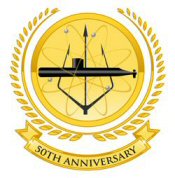
1958

|
USS SARGO (SSN 583)
1958 |

Click on the pictures to enlarge!
| OUTFITTING |
|
Following the highly successful launching in October of 1957 the shipyard
and crew of USS SARGO (SSN 583) completed the construction and outfitting
of the ship readying her for her Initial Sea Trials, in August of 1958.
|

SEA TRIALS
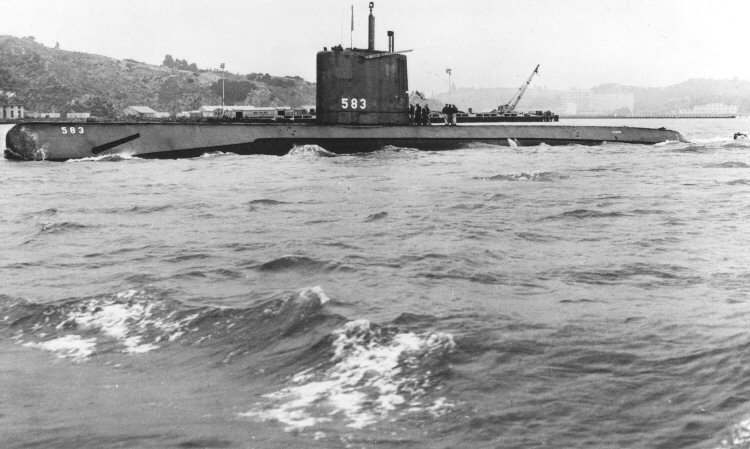 Courtesy Scott Koen
Courtesy Scott Koen
|
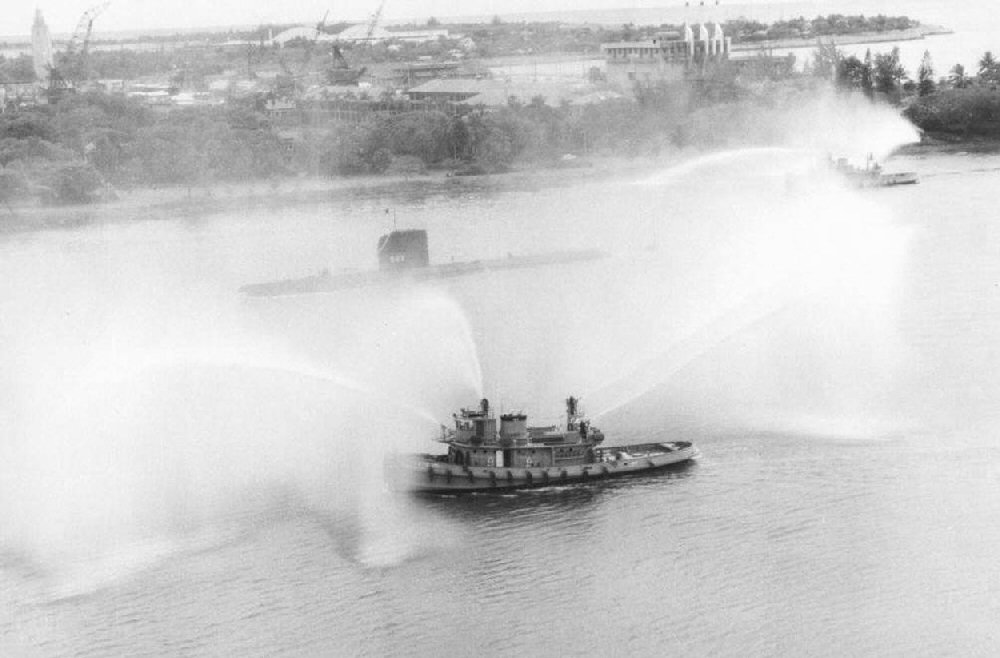 Courtesy Scott Koen
Courtesy Scott Koen
|
| 5 August 1958, Sargo's (SSN-583) is shown returning from her first set of sea trials. | Sargo's (SSN-583) return from a successful Sea Trials. |
| The return of the USS SARGO (SSN 583) following her intial sea trials was covered by the local newspaper: |
| And the newspaper story that followed: |
|
"'It looks like Mare Island has built another real good sub.'
"Those were the words of Comdr. Daniel P. Brooks, USN, skipper of the submarine
Sargo, upon his return to Mare Island yesterday from the first sea trials of the
West Coast's first nuclear-powered sub.
"The trials, which began early Sunday and lasted until yesterday afternoon,
must have been fabulously successful, even beyond the hopes of the officers
and civilians who led the Sargo project, and of Rear Adm. Hyman Rickover, USN,
famed pioneer of naval nuclear power who was on board for the tests.
“For, although the only official word was Brooks brief wire to Mare Island:
‘Trials very successful,’ he had this to say last night: ’We really put her
through her paces and we didn’t find a single bug.’
“A performance of that kind is nothing short of amazing, as any Navy skipper
will agree, for a ship of any type making her maiden sea trial.
“There are a thousand things that can go wrong, from malfunction of parts to
leaks in the bilges, but the youthful Sargo skipper maintained the rigorous
trials turned up no defect even remotely worthy of mention.
“’The ship worked so well, we hated to go to bed at night,’ he laughed.
“Aside from his ringing praise of the quality of work turned out by Mare
Islanders in their first assignment of building a nuclear-powered submersible,
Commander Brooks had some very kind words for his crew. ‘They really performed
like old pros,’ he declared. ‘I’d have to rank their response to this
challenge right alongside the fine job done by Mare Island.’
“For the record, Commander Brooks reported the Sargo made five dives during
the 60-hour test period in which it ranged over a designated area of the
Pacific west of the Farallon Islands.
“’We were submerged a total of 34 hours and 57 minutes,’ Brooks said, recalling
the figures from the boat’s log. The Sargo remained submerged all night Sunday,
then conducted other test maneuvers Monday and yesterday.
“Admiral Rickover, whose official title is assistant chief of the Bureau of
Ships for Nuclear Power, was reported by Commander Brooks to have expressed
himself as ‘extremely pleased’ both with the performance of Mare Island
workmen in building the Sargo, and with the crew. The crew has been
familiarizing itself with the Sargo’s propulsion plant, reactor and other
features of its operation since last September. They have worked aboard the
ship almost daily since it was launched on October 10.
“Many of the Sargo hands are veterans of service in the Nautilus, first nuclear
sub to be built for the fleet, and some have had duty in the Seawolf, as well.
“So successful was the initial test, Commander Brooks said, that probably only
one more will be necessary before the Sargo is finally commissioned and turned
over to the Pacific Fleet as that unit’s first A-sub. The commissioning
ceremony, incidentally, tentatively planned for early October.
“’But, sometime between now and the, we’ll go to sea in order to prove out a
few more things that need to be tested,’ Brooks said, without elaborating on
their nature.
“’But right now, we’re all too tired to think about the next trial, even though
we’re mighty happy with our boat,’ Commander Brooks concluded.
|

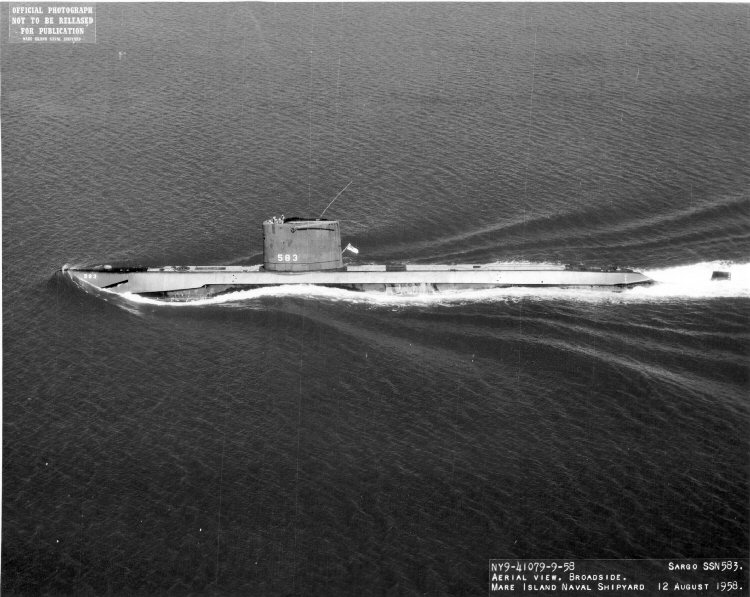 Courtesy Tom Hansen
Courtesy Tom Hansen
|
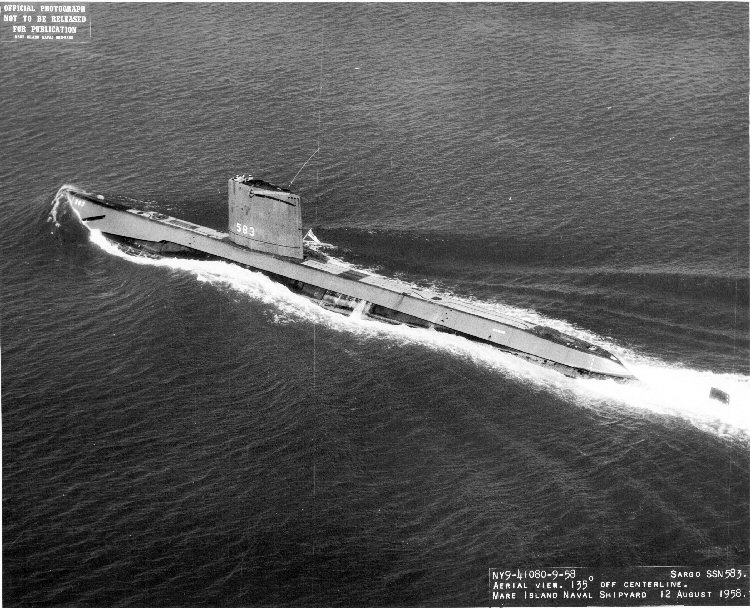 Courtesy Tom Hansen
Courtesy Tom Hansen
|
| Aerial view of USS SARGO (SSN 583), broadside. Photo taken 12 Aug 1958. | Aerial view of USS SARGO (SSN 583), 135-deg off centerline. Photo taken 12 Aug 1958. |
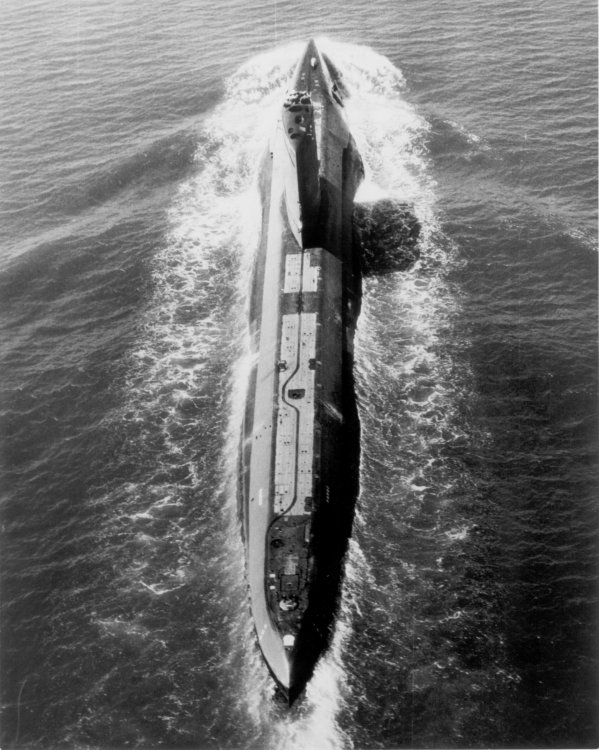 Courtesy Michael Hacking
Courtesy Michael Hacking
|
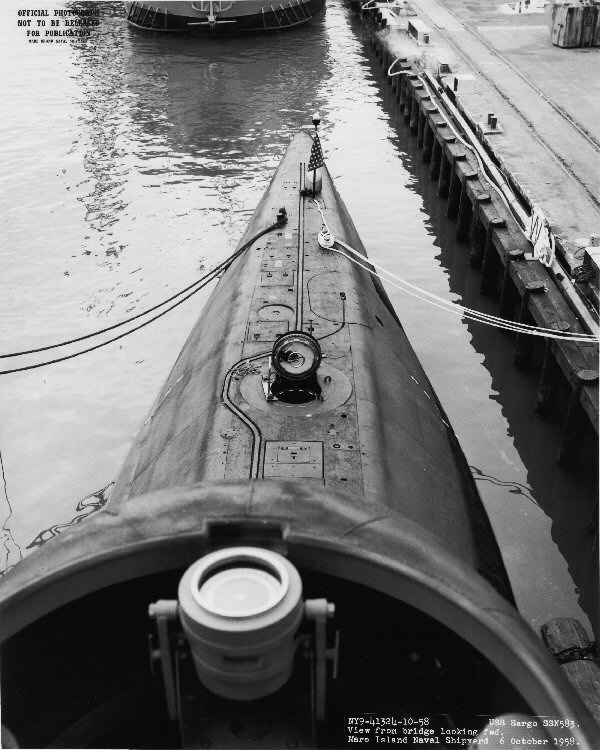 Courtesy Tom Hansen
Courtesy Tom Hansen
|
| Stern view of USS SARGO (SSN 583). Photo taken September 1958. | View of USS SARGO (SSN 583) from bridge looking forward. Photo taken on 06 Oct 1958. |
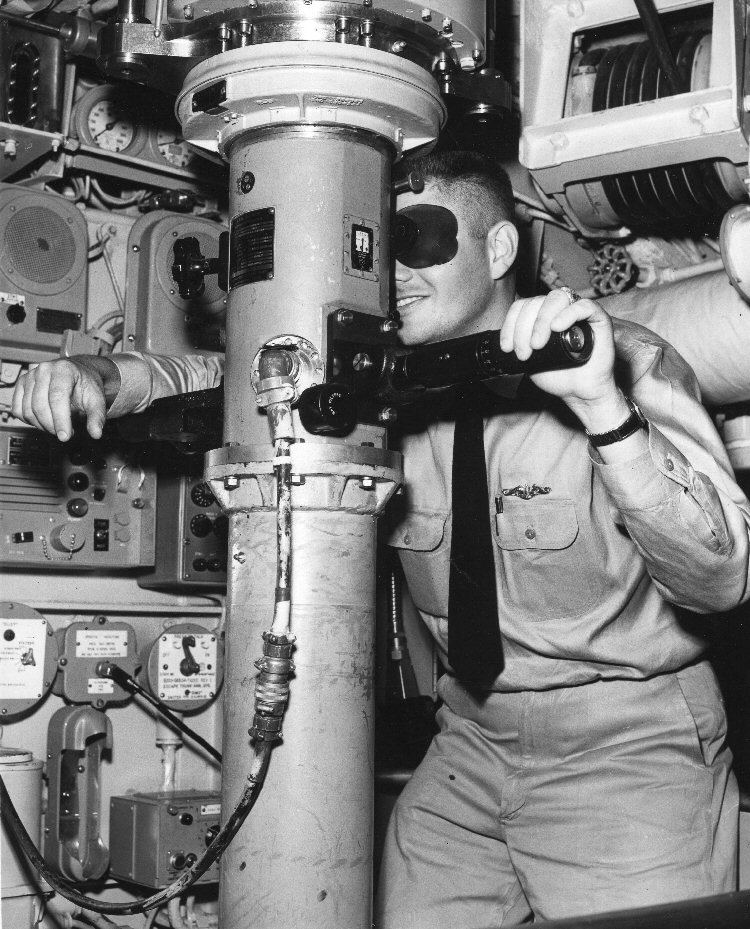 Courtesy Vallejo Naval and Historical Museum via Darryl Baker
Courtesy Vallejo Naval and Historical Museum via Darryl Baker
|
|
LT Whitney Hansen sights USS SARGO's (SSN 583) submerged scope several days before
her commissioning in October 1958.
[U.S. Navy Photo] |

COMMISSIONING

|
At the moment the commissioning pennant is broken, a ship becomes the
responsibility of the Commanding Officer, who, together with the ship’s officers
and men, has the duty of making her ready for any service required by our
nation, whether at peace or at war.
The commissioning pennant has for centuries been the symbol of a man-o-war. It is believed to date from the 17th century, when the Dutch were at war with the English. Dutch Admiral Maarten Harpertzoon Tromp hoisted a broom at the masthead to symbolize his intention to sweep the English from the sea. This gesture was answered by British Admiral William Blake, who hoisted a horsewhip indicating his intention to chastise the Dutch. The victorious Brittish thus set the precedent for a long, narrow commissioning pennant to symbolize the original horsewhip as the distinctive symbol of a ship of war. The modern U.S. Navy commissioning pennant is blue at the hoist with a union of seven white stars and a horizontal red and white stripe at the fly. The original design had 13 rather than 7 stars, but the number was reduced as the length of the pennant was shortened over the years. The ceremonies for commissioning and decommissioning a U. S. Navy warship call for the hoisting of the ensign, jack, and commission pennant as the first act after the new captain has read the commissioning order, and as the final act before the last captain declares the ship decommissioned. The commissioning of the USS SARGO took place at Mare Island Naval Shipyard, Vallejo, California on 01 Oct 1958. Reading from the ship’s Commissioning Program (provided courtesy Frank Munroe) the ceremony and the ship were described as follows: |
|
“The U. S. S. SARGO (SS(N) 583) is being commissioned today as the newest in
the Navy’s growing fleet of nuclear powered submarines. SARGO is the first
nuclear powered submarine to be built on the West Coast. Her keel was laid on
21 February 1956 and she was launched on 10 October 1957. She is 267 feet long,
displaces 2350 tons and can steam around the world without refueling. She
carries a crew of more than 80 officers and men. SARGO is an attack type
submarine and is equipped with the newest torpedoes and the most advanced
electronic and fire control equipment.
“The United States and the free world today face a formidable threat from a large number of Soviet submarines, many of which are capable of launching missiles with nuclear warheads. Defense against this threat in great part will be dependent upon an adequate number of United States nuclear-powered attack submarines, coupled with the deterrent effect of adequate numbers missile carrying nuclear submarines." |
| One of the photos released to the press is shown below: |
| The Vallejo Times-Herald newspaper story which accompanied the photo above: |
|
The Pacific Coast’s first nuclear-powered submarine – USS Sargo – formally
joined the fleet yesterday afternoon at Mare Island Naval Shipyard amid
sun-drenched ceremonies attended by about 700, largest gathering at a Mare
Island commissioning since World War II days. The ship was turned over to
Comdr. Daniel P. Brooks, USN, named more than a year ago as her prospective
commander.
Commissioning of the Sargo yesterday culminated four years of preparation,
planning, research, design and the actual building of the nuclear under-sea
craft. The ceremonies, in a sense, marked Mare Island’s graduation into the
ranks of the nuclear-ship building yards.
HER COST, $48 million makes the Sargo the most expensive of the nearly 500
ships delivered to the fleet by Mare Island in the shipyard’s 104-year history,
but her commissioning speaker, Vice Adm. Maurice E. Curts, USN, commander of
the Western Sea Frontier and Pacific Reserve Fleet, declared: "She will show a
fine net return, whether we are at war or at peace."
Admiral Curts added, however, as he addressed the audience from the crowded
deck of the Sargo: "To achieve the maximum return will demand imagination and
judgment," and directing his remarks to the officers and crew: "You and your
men are the pioneers of America’s new Navy, and I know that you are inspired
by Commander William K. Anderson and the Nautilus, and Commander Calvert,
skipper of the Skate, sister ship of the Sargo."
The speaker also paid tribute to Mare Island workmen, noting that "today is
truly an historic occasion, because, up to now at least, it could happen only
once in a lifetime. It happened when you built sailing ships. It happened again
when you built the first coal-burning ship, and again when you built the first
oil-burning ship.
"AND NOW," he said, "you have built a nuclear-powered submarine. It would be
difficult to imagine what the next power transition will be, but when it comes,
I am confident your descendents in Mare Island Shipyard will be building that,
too."
Admiral Curts went on to praise the other principal contributors to the
building of the Sargo - the Bureau of Ships, headed by Rear Adm. Albert G.
Mumms, USN, a former Mare Island Naval Shipyard commander, which was
responsible for design; the Bureau of Ordinance for the weapons system, and to
the Reactor Division of the Atomic Energy Commission, headed by Rear Adm. Hyman
G. Rickover, USN.
The Sargo is probably the most nearly completed ship Mare Island has ever
commissioned, already having logged more than 1,500 miles in sea trials. These
recent and outstandingly successful trials were noted by Admiral Curts as he
"borrowed a page" from the report on them from the absent shipyard commander
Rear Adm. Martin J. Lawrence, USN.
"ADMIRAL, Lawrence said on her first trip to sea, 'we were able to run
up to full power and keep her there for several hours. We were able to bank her,
turn her, back her down full, and practically stand her on her head, and she
performed like a thoroughbred'," the speaker quoted from the report.
Then he said, " I don't know why it should be necessary to stand a submarine on
her head, but the Sargo apparently is capable of it."
To Commander Brooks and the officers and crew of the Sargo, Admiral Curts said
as he concluded his address: "I congratulate you. I wish you well. I wish you
smooth sailing. And I wish you peaceful sailing!"
Since the Sargo already has been to sea, she was flying the American flag at
her commissioning yesterday and only the commissioning pennant was raised.
THE SUBMARINE'S imminent availability as a member of the Pacific
Submarine Force was noted with relish by the force commander, Rear Adm. Elton
W. (Joe) Grenfell, USN.
"The Pacific Submarine Force and the whole Pacific Fleet feel this is a most
magnificent day for them, for we are anxiously awaiting the Sargo," Admiral
Grenfell said.
"We have been waiting to try out new tactics using the Sargo's high speed and
endurance. We want to use her with conventional submarines to see if or how well,
the complement each other. We want to use her as a target in anti-submarine
warfare; in fact, much of Sargo's time will be devoted to that important task,"
he added.
THE FORCE commander promised the sub's crew a busy time in the months
ahead, forecasting tours of duty with the Seventh Fleet in the far East and visits
to the SEATO nations.
Terming the ship a "magnificent masterpiece" of Mare Island's, Admiral Grenfell
declared himself as certain the Sargo crew would make her "the outstanding sub
in the Force."
He then read a message of congratulations for Adm. Herbert G. Hopwood, USN,
commander-in-chief of the Pacific Fleet.
Admiral Grenfell, who was introduced by Capt. Lowell T. Stone, USN, commander of
Mare Island Submarine Administration, then introduced Rear Adm. Elmer E. Yeomans,
USN, now superintendent of the Naval Post-Graduate School in Monterey, but who was
the first skipper of the original Sargo.
ADMIRAL YEOMANS told Commander Brooks that "this fine old shipyard has
given you a better ship than we had, but we were mighty proud of the first Sargo
that day about 20 years ago when we commissioned her. I offer you every good wish,"
he concluded.
The principle speaker, Admiral Curts, was introduced by Rear Adm. George L.
Russell, USN, commandant of the 12th Naval District, who praised the vice-admiral
as "an officer who's been a natural for every assignment handed him since he's
been in the Navy."
The ship was turned over to Admiral Russell for commissioning by Capt. Leo G. May,
USN, acting as shipyard commander in Admiral Lawrence's absence in Washington, D.C.
THE DISTRICT commandant read the commissioning orders then directed Commander
Brooks to place the ship in commission. This order was carried out, and the 12th
District Band broke into its rendition of the national anthem.
At its conclusion, Commander Brooks introduced Mrs. Frank Watkins, sponsor of the
Sargo at the ship's launching last Oct. 10. Mrs. Watkins, wife of the commandant of
the 13th Naval District, presented the ship with a guest book.
The invocation was offered by Lieut. Comdr. A. F. Mendosa, (ChC), USN, and the
benediction by Comdr. H. W. Buckingham, (ChC), USN senior shipyard chaplain.
A RECEPTION, attended by about 200 guests, followed at the Commissioned
Officers Mess.
The 2,190-ton Sargo is the fifth nuclear-powered submarine to be placed in
commission. She is 267 feet long and has a 25-foot beam.
Most of the Sargo officers and crew have been at Mare Island since the ship was
launched almost a year ago, arriving early to be indoctrinated in the operation
of the boat.
On Monday, the Sargo will depart Mare Island for Pearl Harbor, where she will
join the Pacific Submarine Force.
Her departure will leave Mare Island's nuclear sub building program at four ships.
They include the missile-firing Halibut, due for launching in early 1959; the
SSGN-600, Polaris missile submarine; the Scamp and the Permit.
|
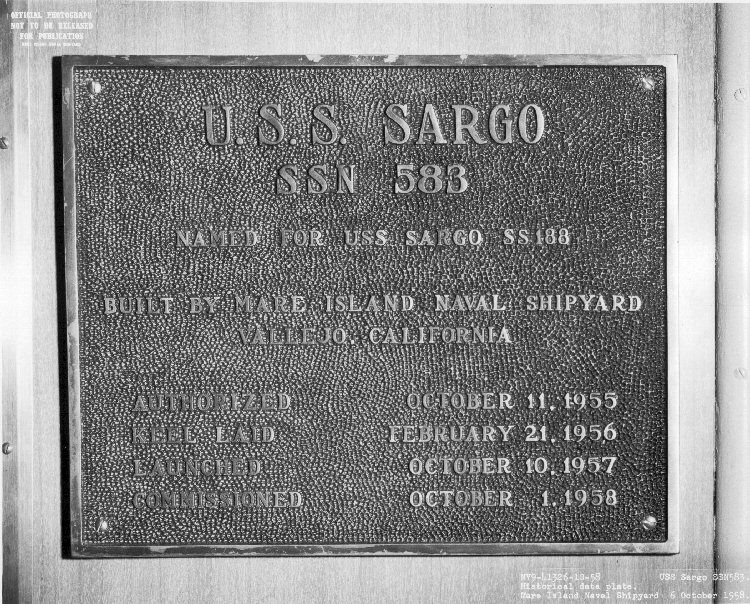 Courtesy Tom Hansen
Courtesy Tom Hansen
|
| The Commissioning Plaque. Photo taken in October 1958. |

| Follow this link to the Commissioning Crew |
| The following photos of shipmates from the commissioning crew were provided by Ellie Goode: |

|
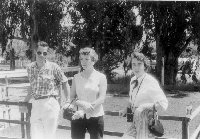
|
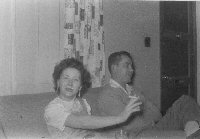
|
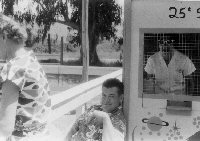
|
| Earl L. Gayle MMC(SS) | Floyd L. Laughrun CS1(SS) | ENS Herbert E. Menzel, Jr. | LeRoy Ingles TMC(SS) - COB |
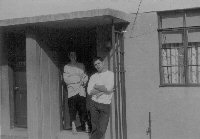
|

|
||
| Phillip S. Thompson EN1(SS) | William J. Andrew EN2(SS) |

|
On Thursday the wives of Submarine Officers of Submarine Administration, Mare Island Group and submarines present at Mare Island held their monthly luncheon at the Commissioned Officers Mess. Wives of the officers of the USS Sargo acted as hostesses. Gathering for the cocktail hour before the luncheon were Mrs. J. S. Smith, Mrs. W. F. Kopaka, Mrs. Kenneth Riley, Mrs. Charles Wright, Mrs. D. M. Wells, Mrs. M. C. Hansen, Mrs. W. J. McCreevey, Mrs. Lowell T. Stone, Mrs. Hugh Nott, Mrs. Joseph Donohue, Mrs. D. Henderson, Mrs. Paul Fossum. Mrs. Robert Owens, Mrs. Wm. Cannon, Mrs. Samuel Ellis, Mrs. Daniel Brooks, Mrs. L. Guille, Mrs. Robert Hay, Mrs. S. J. Anderson, Mrs. Paul Tomb, Mrs. R. M Douglass, Mrs. T. Carter, Mrs. M. Burnett, Mrs. Roderick MacLean, Mrs. W. A. Bowes, Mrs. J. R. Schulte, Mrs. E. O. Dietrich, Mrs. Philip Ruth, and Mrs. John McConeghy.
|

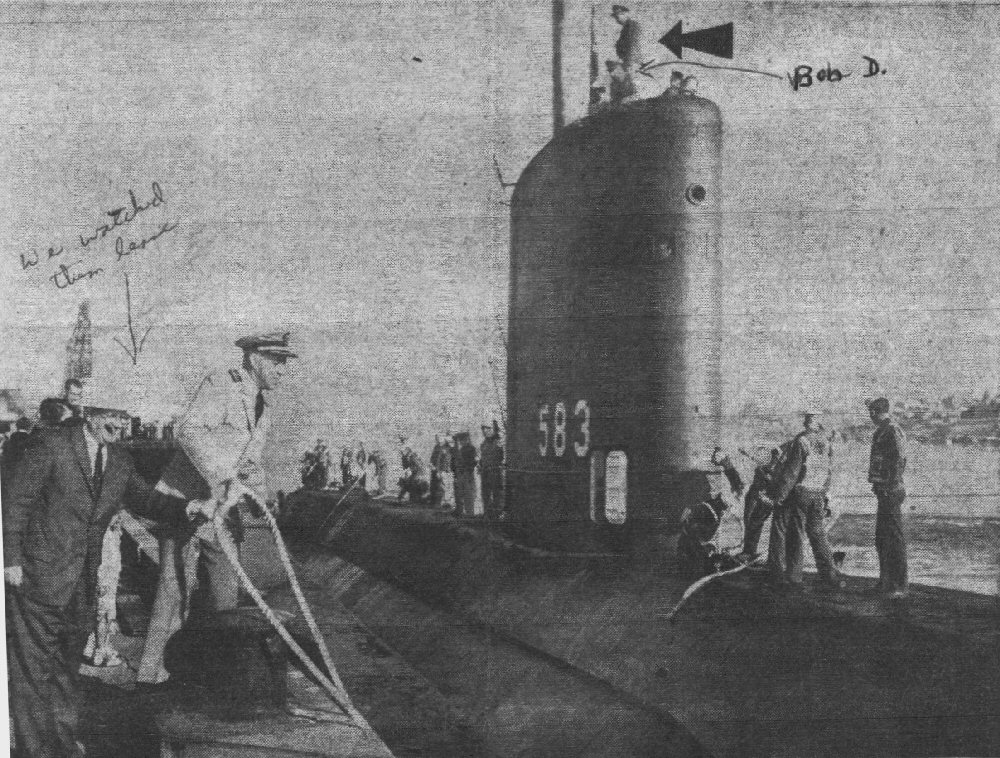 Courtesy Robert Douglass
Courtesy Robert Douglass
|
|
With Comdr. Daniel P. Brooks, USN (arrow), standing at the top of the sail, the atomic submarine Sargo, first nuclear sub ever built at Mare Island Naval Shipyard, departed this morning for Hawaii. The boat is due there next Tuesday to join the Pacific Submarine Force. Irwin H. Whitthorne, master of Shop 56, and Comdr. E. E. Kintner, USN, shipyard nuclear power superintendent, had the honor of casting off the bow lines -- Vallejo News Chronicle Photo (08 Oct 1958) |
| The USS SARGO (SSN583) conducted refresher training during a transit to Hawaii, arriving at Pearl Harbor on 16 Oct 1958. |

| During the balance of October 1958 the USS SARGO (SSN 583) conducted refresher training. While underway she fired four warshot MK-14-5 torpedoes, sinking the damaged USS CHITTENDEN COUNTY (LST 561). |
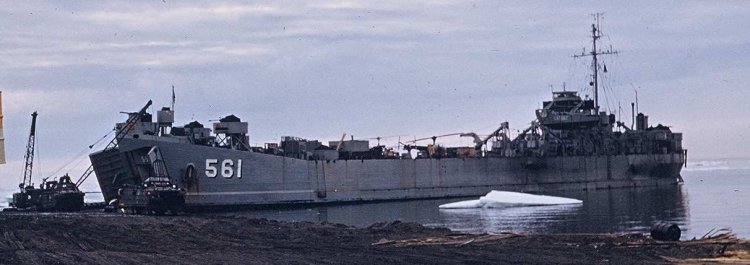
|
| This picture of LST 651 was taken during the summer of 1955 while on a trip to the Arctic. |
|
Leo Miller, MMC(SS) aboard for the exercise, provided the following six
periscope shots of the torpedo firing and the sinking of the CHITTENDEN COUNTY
(LST 561) on 21 Oct 1958:
|
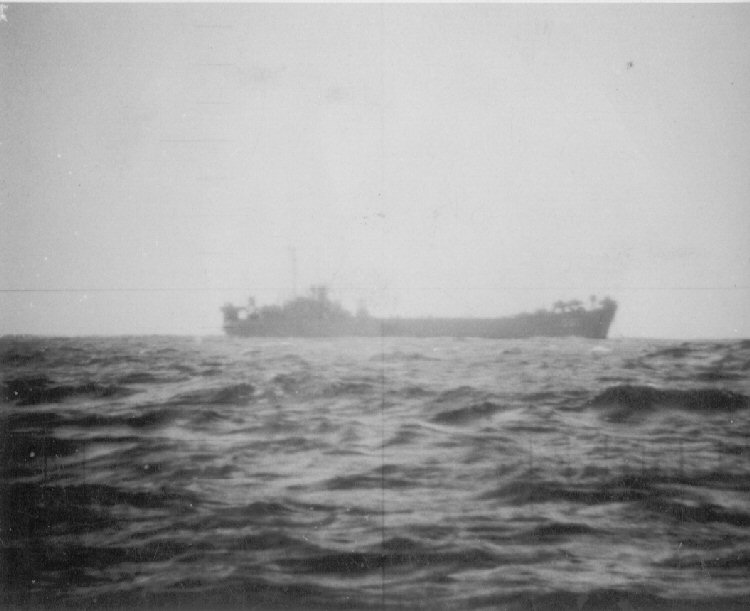
|
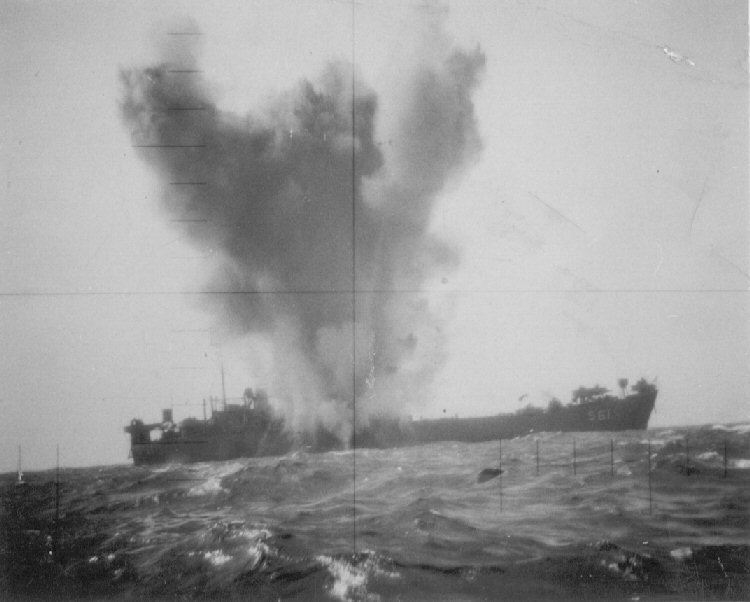
|
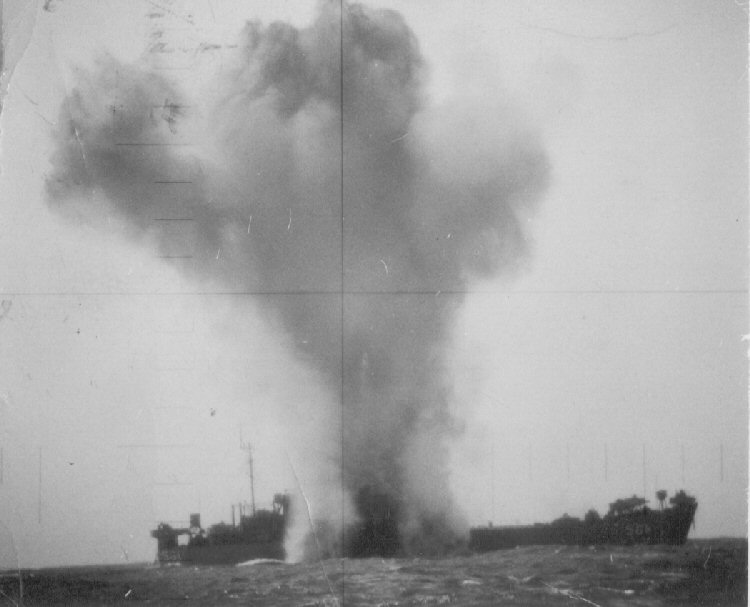
|
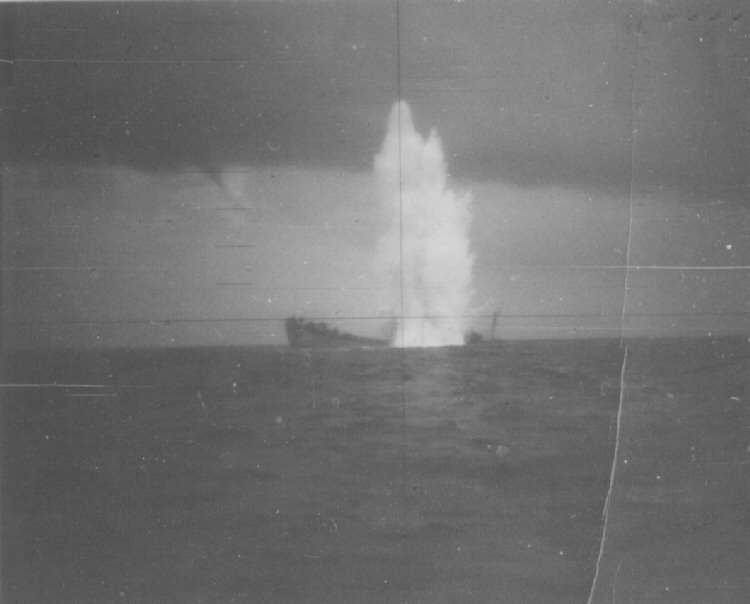
|
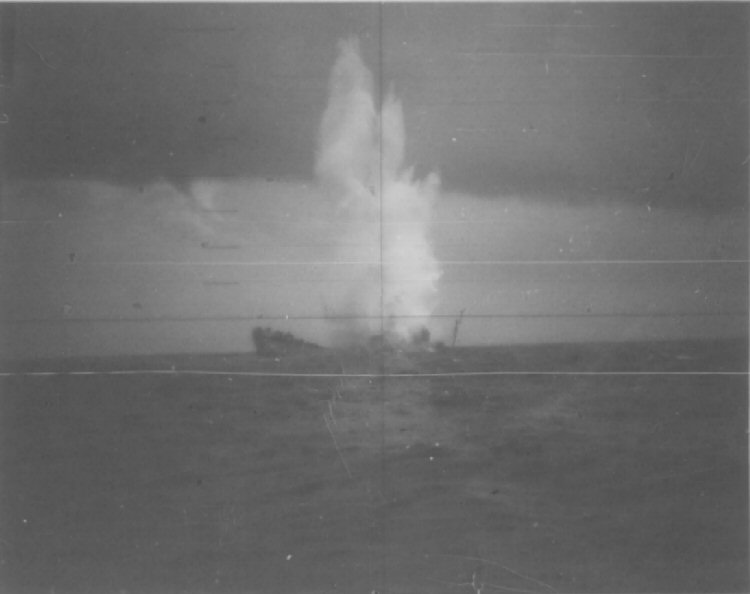
|
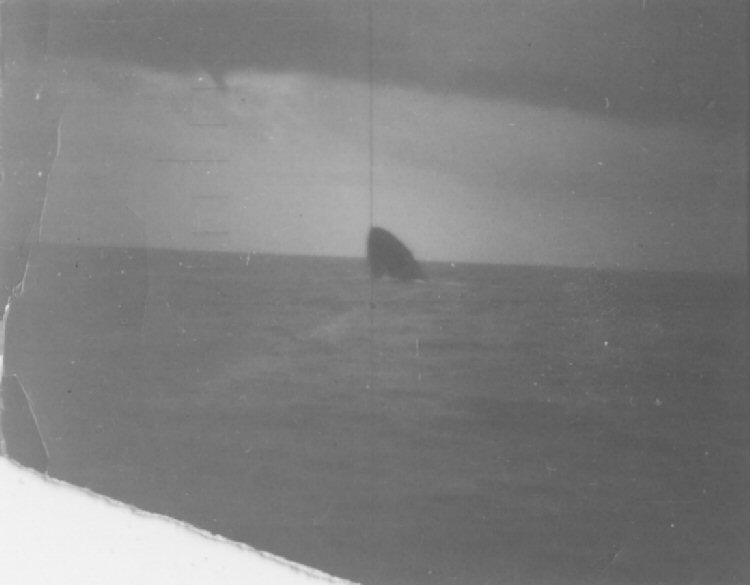
|
| Follow this link to the 15 May 1959 edition of the Mare Island Grape Vine |
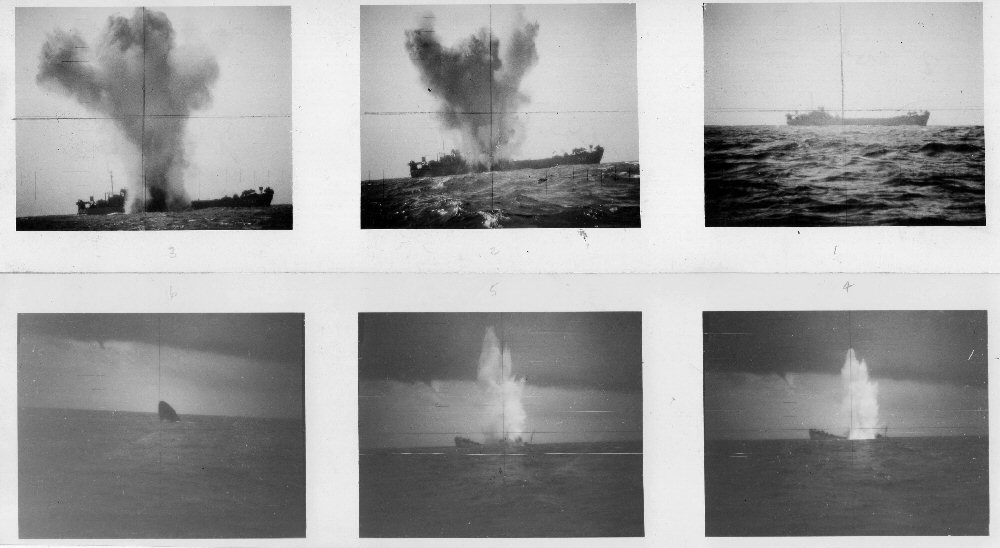 Courtesy Vallejo Naval and Historical Museum via Darryl Baker
Courtesy Vallejo Naval and Historical Museum via Darryl Baker
|
|
Periscope photos of the USS SARGO (SSN 583) sinking the ex-Chittenden (LST 561)
on 21 Oct 1958.
[U.S. Navy Photo] |

|
Following the successful torpedo testing off of the coast of Oahu, Hawaii the USS SARGO (SSN 583) deployed to Puget Sound, Washington for extensive sound trials at Carr Inlet, followed by torpedo tube acceptance trials at Dabob Bay. The USS SARGO (SSN 583) was the first submarine to work the station at Dabob Bay in tracking the underwater course of the newly developed acoustic torpedoes and their characteristic runs.
|
| The following article from a local newspaper reported the arrival of the USS SARGO: |
|
A Puget Sound mist greeeted the crew of the nuclear-powered submarine USS Sargo as shee moored along the wharf at Bangor Naval Ammunition Depot late yesterday afternoon. Comdr. Daniel P. Brooks, skipper of the fleet's newest sub can be seen atop the conning tower near the radio and periscopes. The Sargo entered Puget Sound submerged using her radar and periscopes for navigation. |
| Following the successful sound trials at Puget Sound the USS SARGO finished 1958 in an upkeep and repair period at Mare Island Naval Shipyard." |
